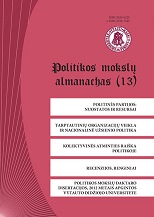Jungtinių tautų organizacijos taikos palaikymo operacijų planavimas ir sprendimų priėmimas
Un peacekeeping operations planning and decision-making
Author(s): Gražvydas JasutisSubject(s): Politics / Political Sciences
Published by: Vytauto Didžiojo Universitetas
Keywords: Jungtinių Tautų Organizacija; taikos palaikymas; operacijos; planavimas; United Nations; peacekeeping; operations; planning
Summary/Abstract: Šiame straipsnyje įvertinamas Jungtinių Tautų (toliau – JT) integruotų taikos palaikymo operacijų planavimo procesas, kuris formaliai pradėtas 2007 m. Pateikiama informacijos apie vykdomas JT operacijas, JT departamentų ir agentūrų veiklą, susijusią su taikos palaikymu. Detaliai analizuojamas sprendimų priėmimo procesas pagal JT struktūrą. Įvardijamos pagrindinės problemos ir iššūkiai, su kuriais susiduria dabartiniai JT operacijų planuotojai. Visos JT taikos palaikymo operacijos unikalios, ir gana sudėtinga pritaikyti unifikuotą modelį pačiam planavimo procesui, todėl straipsnyje apibrėžiant bendrą planavimo modelį, kuris nustato planavimo gaires ir gali būti taikomas lanksčiai, remiamasi JT dokumentais ir dabartine operacijų planavimo patirtimi. This article was focused on the UN Integrated Mission Planning Process, which was launched in 2007. The aim was to thoroughly analyze UN peace keeping operational planning and decision-making process. The research object was UN planning process, its institutional interaction and division of labor within the organization. The first part of the article was devoted to UN peacekeeping operations and mission to be deployed around the globe. Substantial statistical data were presented with regard to the countries financial and human resources contribution to the operations. Five general trends of UN peacekeeping functions were identified and consequently explained. The second part was concentrated on the integrated mission planning process. It explained the decision-making process in peacekeeping within UN structures, the involvement of its agencies and institutions in the course of operational planning. It evaluated the process in a structured way identifying major problems and challenges to be tackled. The article concluded that integrated planning helped clearly identifying UN institutional division of labor and functions in peacekeeping and its operational planning. The introduced planning stages contribute to the quicker reaction to the eruption of crisis and the deployment of peacekeeping elements. However, new planning could not solve the problems related to state national interests which prevail at any stage of planning and decision-making.
Journal: Politikos mokslų almanachas
- Issue Year: 2013
- Issue No: 13
- Page Range: 73-98
- Page Count: 26
- Language: Lithuanian

